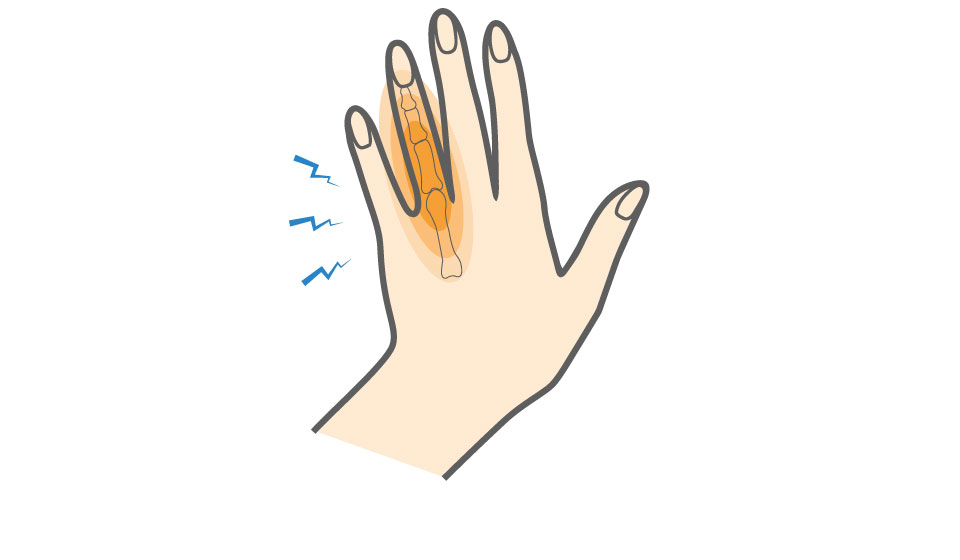Each finger comprises three bones, called phalanges, except for the thumb, which includes only two phalanges. The phalanges connect to the metacarpal bones of the hand. The bones within each finger are connected by bands of flexible tissue called ligaments. A finger sprain is a tear or stretch of the ligaments in the fingers. While finger sprains are common among athletes, they are highly treatable and typically result from hand trauma.
Finger Sprain Causes, Symptoms & Treatment Options
Each finger comprises three bones, called phalanges, except for the thumb, which includes only two phalanges. The phalanges connect to the metacarpal bones of the hand. The bones within each finger are connected by bands of flexible tissue called ligaments. A finger sprain is a tear or stretch of the fingers' ligaments—a common finger joint injury resulting from overuse or impact.
Overview
Overview

What causes Finger Sprain?
Finger sprains are caused by a physical force to the finger that over-stretches or tears the ligaments in the finger. This injury can occur due to a fall on an outstretched hand or when a ball jams or bends an outstretched finger. This kind of hand trauma often leads to a finger ligament tear. Finger sprains frequently result from a sports injury and are most common in these sports:
• Basketball
• Baseball
• Softball
• Gymnastics
• Football
• Rugby
Symptoms
With a finger strain, athletes usually experience pain or stiffness in the affected finger joint. Other common symptoms include:
• Swelling
• Tenderness
• Limited mobility
• Bruising
When to see a doctor
If you have injured your finger and it doesn’t improve within three or four days, you should see your doctor. At your appointment, be sure to provide the details of your injury and the sports you play. This information will help your doctor make a diagnosis and determine whether you have a finger joint injury or another type of hand trauma.
During a physical examination of your finger, your doctor will look for signs of swelling and tenderness. You may be asked to extend and flex your finger to see if you have limited mobility. X-rays may be ordered to help your doctor evaluate the extent of your injury and determine if you have fractured or only sprained your finger.
Non-operative treatment
While common, finger sprains are also highly treatable with non-surgical measures. Treatment may include:
• Applying ice to reduce swollen finger symptoms and pain
• Keeping your finger elevated, especially at night, to reduce swelling
• Gently moving your finger to prevent stiffness
• Taking anti-inflammatory medication (e.g. aspirin, ibuprofen, or naproxen) for pain
• For more severe cases, it may be necessary to immobilize the finger for a short period of time using a splint or buddy taping to the next finger.
You can also try these exercises at home:
Recovery
Most finger sprains will fully heal within three to six weeks. A full return to sport will depend on the severity of the finger ligament tear or finger joint injury, and occupational therapy may be helpful in your recovery. Often, it is beneficial to protect the finger by taping when you first return to play to avoid re-injury.
GET BACK TO WHAT YOU LOVE. FASTER
Frequently Asked Questions
How Long Does Healing Take?
- Mild sprain: Recovery may take up to 3 weeks.
- Severe sprain: Healing could extend to 6–8 weeks.
Your healthcare provider will determine when returning to daily activities or sports is safe.
How to Protect a Sprained Finger
Depending on the injury, various protective methods may be used:
- Finger wrap
- Aluminum splint
- Protective taping or buddy taping (pairing the injured finger with a neighboring one)
These measures help prevent further damage during recovery.
What If a Sprained Finger Is Left Untreated?
Ignoring a sprain can lead to:
- Chronic stiffness
- Ongoing pain
Prompt care ensures proper healing and prevents long-term complications.
What is the General Timeline for Sprain Recovery
Healing time varies based on the injury's severity and location:
- Minor sprains: A few days to a 3 weeks
- Moderate to severe sprains: Several weeks to months

